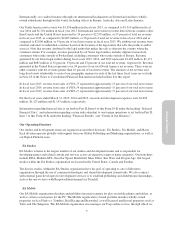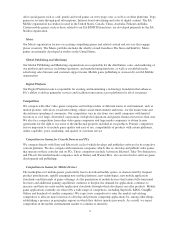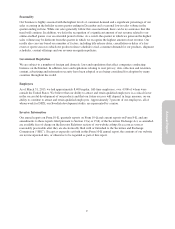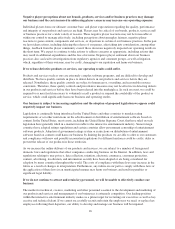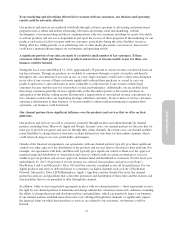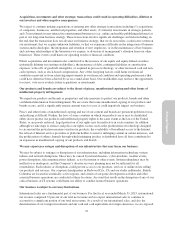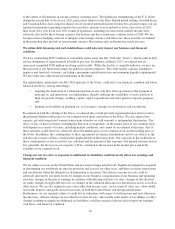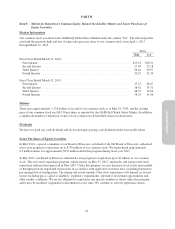Electronic Arts 2015 Annual Report Download - page 83
Download and view the complete annual report
Please find page 83 of the 2015 Electronic Arts annual report below. You can navigate through the pages in the report by either clicking on the pages listed below, or by using the keyword search tool below to find specific information within the annual report.
Annual Report
The console segment of the entertainment software industry is cyclical, driven by the periodic introduction
of new console systems. During the transition period to new console systems, our operating results may be
more volatile.
New video game console systems have historically been developed and released every few years, which causes
the video game software market to be cyclical as well. In periods of transition from legacy generation consoles to
new generation consoles, sales of software for legacy generation console systems typically slow or decline in
response to the anticipated and actual introduction of new consoles, and new generation console software sales
typically stabilize after new consoles are widely-established with the consumer base.
Sony and Microsoft launched the PlayStation 4 and Xbox One, respectively, in November 2013. During fiscal
2015, we saw consumers purchase fewer software products for the Sony PlayStation 3 and Microsoft Xbox 360
legacy generation consoles. Consistent with other transition periods, we expect this trend to continue. This trend
could also accelerate faster than anticipated and may put downward pressure on legacy generation video game
software pricing, which could negatively affect our operating results. Our revenue from software sales for the
PlayStation 4 and Xbox One may not offset the negative effects of this trend on our operating results. In addition,
we do not control the unit volumes of consoles made available for sale or the rates at which consumers purchase
these consoles. As a result, our operating results during this transitional period may be more volatile and difficult
to predict.
Our business is dependent on the success and availability of video game hardware systems and devices
manufactured by third parties, as well as our ability to develop commercially successful products and
services for these systems and devices.
The success of our business is driven in part by the commercial success and adequate supply of video game
console systems, PCs, mobile phones and tablets manufactured by third parties. Our success also depends on our
ability to accurately predict which platforms will be successful in the marketplace and our ability to develop
commercially successful products and services for these platforms. We must make product development
decisions and commit significant resources well in advance of anticipated platform release dates and may incur
significant expense to adjust our product portfolio and development efforts in response to changing consumer
platform preferences. Additionally, we may enter into certain exclusive licensing arrangements that affect our
ability to deliver or market products or services on certain platforms. A platform for which we are developing
products and services may not succeed to the extent expected or new platforms may take market share and game
software consumers away from platforms for which we have devoted significant resources. If consumer demand
for the platforms for which we are developing products and services is lower than our expectations, we may be
unable to fully recover the investments we have made in developing our products and services, and our financial
performance will be harmed. Alternatively, a platform for which we have not devoted significant resources could
be more successful than we had initially anticipated, causing us to not be able to take advantage of meaningful
revenue opportunities.
Our adoption of new business models could fail to produce our desired financial returns.
We are actively seeking to monetize game properties through a variety of new business models, including from
digital content delivery such as online distribution of full games and additional content, free-to-download games
supported by advertising and/or micro-transactions and subscription services. Forecasting our revenues and
profitability for these new business models is inherently uncertain and volatile. Our actual revenue and profit for
these businesses may be significantly greater or less than our forecasts. Additionally, these new business models
could fail for one or more of our titles, resulting in the loss of our investment in the development and
infrastructure needed to support these new business models, as well as the opportunity cost of diverting
management and financial resources away from more successful businesses.
13




